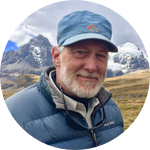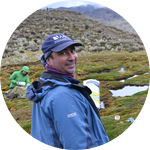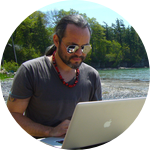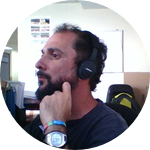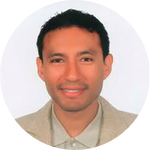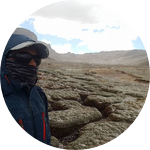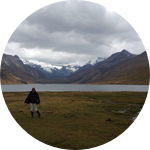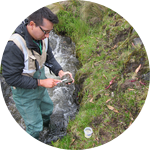About This Project
In the Peruvian Andes it is currently almost impossible to find pristine peatlands to study their natural dynamics. Using satellite images we were able to find what we believe are peatlands untouched by humans, located in the Northern Vilcabamba Cordillera (Otishi National Park). With this project we will confirm if the preliminarly identified sites are peatlands, and will take samples to account their carbon content and install water wells, all to understand peatlands natural variability.
Ask the Scientists
Join The DiscussionWhat is the context of this research?
Nowadays, the environmental and social consequences of climate change, lead us to look for ways to understand, control and mitigate gas emissions. The care and preservation of peatlands could be part of the solution as they have accumulated large amounts of carbon throughout thousands of years.
In Peruvian Andes, there exist numerous places with peatlands; however, study in this region is particularly hard. Identifying appropriate sites to assess the independent effects of climate and human intervention is very difficult, because almost all the Andean territory was historically occupied. Nevertheless, the northern areas of the Vilcabamba Cordillera remains isolated, offering an ideal place to study some peatlands affected only by climatic issues.
What is the significance of this project?
Finding "natural labs" were the human activity is very low (or ideally null) is important to accurately identify the influence of the human intervention in the changes experienced by Andean peatlands and other mountain ecosystems.
The most significant finding of this project would be confirmation of the existence of these “natural labs” in the Otishi National Park.
If the results are positive, we will take core samples, and instrument with water level installations some of these peatlands, because we requires register both: the change patterns experienced by the ecosystems in absence of human pressure and the modifications in the dynamics occurred by the synergy between the environmental instability and the human influence, to propose the best management strategies
What are the goals of the project?
The principal goal of the project is to confirm certain parts of the Vilcabamba mountains in the Otishi National Park (and the Comunitary Reserves that surrounding the National Park) are pristine mountain peatlands. This area represent some difficulties because of its high isolation, high humidity and scarce information, all of which limit access to high quality satellite images.
If, during field work, the team confirms the peatlands presence on the area, we will conduct three additional activities:
(i) A preliminary register of depth transects in the peatlands visited that allows to know (preliminarly) the volume of the peat body
(ii) Take some core samples to quantify the carbon stored, and (possibly) date the peatland age
(iii) Wells installation, to register groundwater fluctuation
Budget
The northern area of the Vilcabamba Cordillera is located on the territories of the Otishi National Park, a particularly isolated region of the Peruvian territory. The optimal way to enter on these territories is the use of helicopters, which can be rented to some providers as the Peruvian National Police, the most important fraction of the required budget, was related with this activity. Some others funds are related with transportation (to the closer town with aerial services), logistics (for 8 days in the field) and the aquisition of one tile probe, an equipment that allows to the researchers measure (preliminarly) the tickness of the peat body.
Endorsed by
 Project Timeline
Project Timeline
After obtain the required budget, the first activity is the coordination of the helicopter rent and the travel to Palmapampa in Ayacucho Region, the proposed date to conclude this activities is the end of August 2018.
The trip was planned for the first week of September 2018 (Dry season).
The first report (confirmatory report of the presence or absence of peatlands in Otishi area) was planned for the last week of September 2018.
Organic matter content Analyses: end October 2018.
Feb 05, 2018
Project Launched
Sep 03, 2018
Travel to Palmapampa
Sep 05, 2018
Fligth to Otishi National Park
Sep 12, 2018
Return fligth to Palmapampa
Sep 28, 2018
First report (confirmatory)
Meet the Team
Affiliates
Affiliates
Affiliates
Team Bio
The Limnology division of CORBIDI was created in 2011, with the aim of generating knowledge for the conservation of functionality and the provision of environmental services from various types of continental aquatic habitats, which are of fundamental importance for the biodiversity, as well as the lifestyle of nearby human communities.
Throughout this period, its members have been working on different projects, such as: river ecology, hydrology, hydrochemistry and functional ecology.
Eduardo Oyague
Mr. Oyague is a Peruvian Biologist, and currently a Master's Candidate in Water Resources Engineering, both in La Molina University.
His research field was related with Limnology, Hydrology and Water Management.
Currently, Eduardo was working for his Master’s Thesis studying the hydrology of Andean Peatlands, and relating how the changes in hydrology can affect the hydraulic conductivity, and the carbon storage capacity.
Adrian Vera Arabe
Mr. Vera is a Peruvian Biologist and researcher of freshwater national environments, with knowledge of ecology, taxonomy of fishes and benthic macroinvertebrates.
Mr. Vera also holds a MBA as a further studies.
Javier Andres
I'm a Bachelor in Science (Biology) with experience in Andean and Amazon freshwater environments. Currently I'm working in my undergraduate thesis studying the benthic macroinvertebrates in Andean peatlands (Nor Yauyos Cochas Landscape Reserve) and how its organization was related with water level fluctuations.
Lucía Cabrejos
Peruvian Bachelor in Science (Biology). I have experience in freshwater biology and instream flow. Learning about hydrology, and integral and sustainable management of water resources.
Gabriel Trujillo Paucar
I am a scientific researcher with experience in applicated ecology of streams, as well as taxonomy of aquatic insects. My topics of interest is ecology of aquatic insects in diverse aquatic habitats in the Peruvian Andes and Amazonia
Lab Notes
Nothing posted yet.
Project Backers
- 8Backers
- 4%Funded
- $156Total Donations
- $19.50Average Donation
